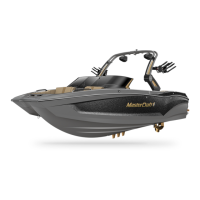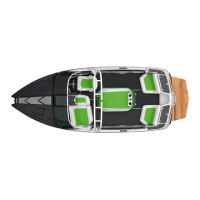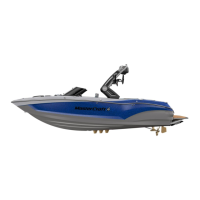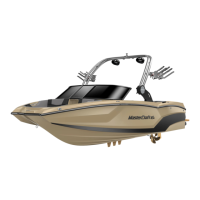Step 2
Add a biocide additive in the fuel tank to limit microbial growth in gas-
oline. Follow the directions provided by the additive’s manufacturer.
Step 3
Add a fuel stabilizer, such as Sta-Bil®, preferably the Marine grade
or Ethanol grade stabilizer, to the fuel tank. Follow the directions
provided by the stabilizer’s manufacturer.
Step 4
Run the engine for at least fifteen (15) minutes while in a body of
water. This allows for the circulation of the additives throughout the
fuel system.
During storage, the tank vents can be sealed. If the vent is sealed,
the tank must NOT be completely filled. A ninety-to-ninety-five per-
cent (90-95%) filled tank allows room for expansion, which will be
required at certain times when temperatures increase. In addition
to preventing water intrusion, sealing can preventing “gumming.”
The hydrocarbons in gasoline react with naturally occurring oxygen
and create a by-product known as “gum.” The substance, as the
name infers, plugs up fuel filters and injectors. Sealing the tank
helps reduce gumming by significantly limiting the amount of oxy-
gen available for interaction with the hydrocarbons. If the tank vent
is sealed for storage/winterization, it is imperative to ensure that
of elements and settling during these periods. Of considerable con-
cern is that water condensation will occur within the fuel system,
and water is an enemy of good-starting and running engine fuel
systems. Therefore, follow this procedure:
Step 1
The fuel tank should be ninety-to-ninety-five percent (90-95%) full
of TOP TIER gasoline. This allows for minimal room in which air can
oxygenate the fuel during diurnal cycles (daily periods of expansion/
con- traction of gasoline vapors and air as a result of temperature
changes). However, MasterCraft boats have EPA-dictated fuel
systems, which means they cannot be overfilled. The boats are
equipped with ullage (overflow) tanks or ullage space in the main
tank. Equipped with several valves to prevent overflow, even in high
heat conditions with 100 percent full fuel, our expansion tanks
will expand by seven-to-nine percent (7-9%), as opposed to the
five percent (5%) required by the EPA. As temperatures rise in the
tank, the pressure also rises, pushing out gasoline vapor-and-air
mixtures. When the temperature falls, pressure lowers and the
system will seek to draw fresh air and water vapor (depending on
the humidity level) into the tank. Fresh air is replaced with “light
ends,” which are low-boiling components that vaporize at ambient
temperatures. Light ends are required during cold starts to vaporize
the fuel. Since the daily diurnal cycles eliminate the light ends, a full
tank helps to minimize the air volume entering the system.
